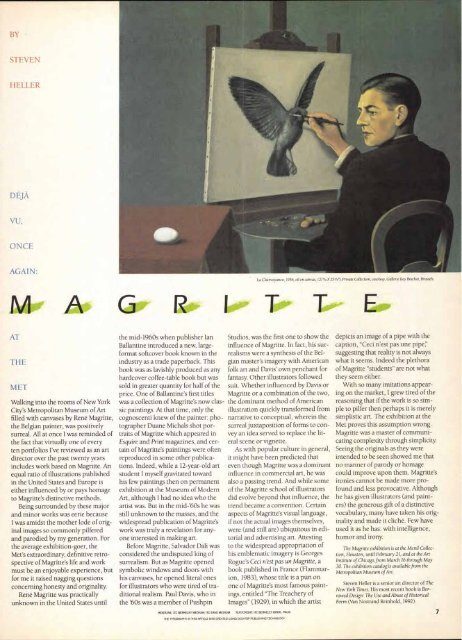Volume 19–4 (Low Res).pdf
Volume 19–4 (Low Res).pdf
Volume 19–4 (Low Res).pdf
Create successful ePaper yourself
Turn your PDF publications into a flip-book with our unique Google optimized e-Paper software.
BY<br />
STEVEN<br />
HELLER<br />
DEJA<br />
ONCE<br />
AGAIN:<br />
AI<br />
THE<br />
MET<br />
A<br />
Walking into the rooms of New York<br />
City's Metropolitan Museum of Art<br />
filled with canvases by Rene Magritte,<br />
the Belgian painter, was positively<br />
surreal. All at once I was reminded of<br />
the fact that virtually one of every<br />
ten portfolios I've reviewed as an art<br />
director over the past twenty years<br />
includes work based on Magritte. An<br />
equal ratio of illustrations published<br />
in the United States and Europe is<br />
either influenced by or pays homage<br />
to Magritte's distinctive methods.<br />
Being surrounded by these major<br />
and minor works was eerie because<br />
I was amidst the mother lode of original<br />
images so commonly pilfered<br />
and parodied by my generation. For<br />
the average exhibition-goer, the<br />
Met's extraordinary, definitive retrospective<br />
of Magritte's life and work<br />
must be an enjoyable experience, but<br />
for me it raised nagging questions<br />
concerning honesty and originality.<br />
Rene Magritte was practically<br />
unknown in the United States until<br />
R<br />
the mid-1960s when publisher Ian<br />
Ballantine introduced a new, largeformat<br />
softcover book known in the<br />
industry as a trade paperback. This<br />
book was as lavishly produced as any<br />
hardcover coffee-table book but was<br />
sold in greater quantity for half of the<br />
price. One of Ballantine's first titles<br />
was a collection of Magritte's now classic<br />
paintings. At that time, only the<br />
cognoscenti knew of the painter: photographer<br />
Duane Michals shot portraits<br />
of Magritte which appeared in<br />
Esquire and Print magazines, and certain<br />
of Magritte's paintings were often<br />
reproduced in some other publications.<br />
Indeed, while a 12-year-old art<br />
student I myself gravitated toward<br />
his few paintings then on permanent<br />
exhibition at the Museum of Modern<br />
Art, although I had no idea who the<br />
artist was. But in the mid '60s he was<br />
still unknown to the masses, and the<br />
widespread publication of Magritte's<br />
work was truly a revelation for anyone<br />
interested in making art.<br />
Before Magritte, Salvador Dali was<br />
considered the undisputed king of<br />
surrealism. But as Magritte opened<br />
symbolic windows and doors with<br />
his canvases, he opened literal ones<br />
for illustrators who were tired of traditional<br />
realism. Paul Davis, who in<br />
the '60s was a member of Pushpin<br />
La Clairvoyance, 1936, oil on canvas, (21/2 X 25 '/2"), Private Collection, courtesy, Gallerie Isey Brachot, Brussels.<br />
Studios, was the first one to show the<br />
influence of Magritte. In fact, his surrealisms<br />
were a synthesis of the Belgian<br />
master's imagery with American<br />
folk art and Davis' own penchant for<br />
fantasy. Other illustrators followed<br />
suit. Whether influenced by Davis or<br />
Magritte or a combination of the two,<br />
the dominant method of American<br />
illustration quickly transformed from<br />
narrative to conceptual, wherein the<br />
surreal juxtaposition of forms to convey<br />
an idea served to replace the literal<br />
scene or vignette.<br />
As with popular culture in general,<br />
it might have been predicted that<br />
even though Magritte was a dominant<br />
influence in commercial art, he was<br />
also a passing trend. And while some<br />
of the Magritte school of illustrators<br />
did evolve beyond that influence, the<br />
trend became a convention. Certain<br />
aspects of Magritte's visual language,<br />
if not the actual images themselves,<br />
were (and still are) ubiquitous in editorial<br />
and advertising art. Attesting<br />
to the widespread appropriation of<br />
his emblematic imagery is Georges<br />
Rogue's Ceci n'est pas un Magritte, a<br />
book published in France (Flammarion,<br />
1983), whose title is a pun on<br />
one of Magritte's most famous paintings,<br />
entitled "The Treachery of<br />
Images" (1929), in which the artist<br />
look' asp(<br />
depicts an image of a pipe with the<br />
caption, "Ceci n'est pas une pipe:'<br />
suggesting that reality is not always<br />
what it seems. Indeed the plethora<br />
of Magritte "students" are not what<br />
they seem either.<br />
With so many imitations appearing<br />
on the market, I grew tired of the<br />
reasoning that if the work is so simple<br />
to pilfer then perhaps it is merely<br />
simplistic art. The exhibition at the<br />
Met proves this assumption wrong.<br />
Magritte was a master of communicating<br />
complexity through simplicity.<br />
Seeing the originals as they were<br />
intended to be seen showed me that<br />
no manner of parody or homage<br />
could improve upon them. Magritte's<br />
ironies cannot be made more profound<br />
and less provocative. Although<br />
he has given illustrators (and painters)<br />
the generous gift of a distinctive<br />
vocabulary, many have taken his originality<br />
and made it cliche. FeW have<br />
used it as he has: with intelligence,<br />
humor and irony.<br />
The Magritte exhibition is at the Menil Collection,<br />
Houston, until February 21, and at the Art<br />
Institute of Chicago, from March 16 through May<br />
30. The exhibition catalogis available from the<br />
Metropolitan Museum of Art.<br />
Steven Heller is a senior art director of The<br />
New York Times. His most recent book is Borrowed<br />
Design: The Use and Abuse of Historical<br />
Form (Van Nostrand Reinhold, 1992).<br />
HEADLINE: ITC BERKELEY MEDIUM; ITC ERAS MEDIUM TEXT/CREDIT: ITC BERKELEY BOOK, ITAUC 7<br />
THE TYPOGRAPHY IN THIS ARTICLE WAS CREATED USING DESKTOP PUBUSHING TECHNOLOGY
















